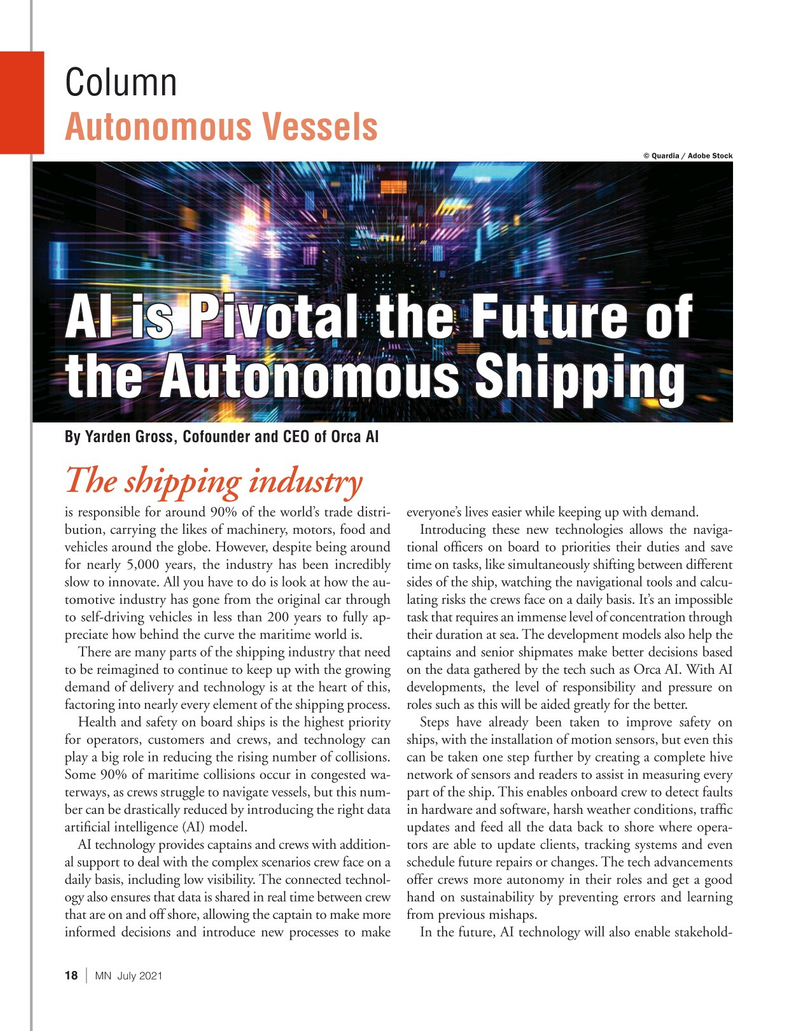
Page 18: of Marine News Magazine (July 2021)
Propulsion Technology
Read this page in Pdf, Flash or Html5 edition of July 2021 Marine News Magazine
Column
Autonomous Vessels © Quardia / Adobe Stock
AI is Pivotal the Future of the Autonomous Shipping
By Yarden Gross, Cofounder and CEO of Orca AI
The shipping industry is responsible for around 90% of the world’s trade distri- everyone’s lives easier while keeping up with demand.
bution, carrying the likes of machinery, motors, food and Introducing these new technologies allows the naviga- vehicles around the globe. However, despite being around tional of? cers on board to priorities their duties and save for nearly 5,000 years, the industry has been incredibly time on tasks, like simultaneously shifting between different slow to innovate. All you have to do is look at how the au- sides of the ship, watching the navigational tools and calcu- tomotive industry has gone from the original car through lating risks the crews face on a daily basis. It’s an impossible to self-driving vehicles in less than 200 years to fully ap- task that requires an immense level of concentration through preciate how behind the curve the maritime world is. their duration at sea. The development models also help the
There are many parts of the shipping industry that need captains and senior shipmates make better decisions based to be reimagined to continue to keep up with the growing on the data gathered by the tech such as Orca AI. With AI demand of delivery and technology is at the heart of this, developments, the level of responsibility and pressure on factoring into nearly every element of the shipping process. roles such as this will be aided greatly for the better.
Health and safety on board ships is the highest priority Steps have already been taken to improve safety on for operators, customers and crews, and technology can ships, with the installation of motion sensors, but even this play a big role in reducing the rising number of collisions. can be taken one step further by creating a complete hive
Some 90% of maritime collisions occur in congested wa- network of sensors and readers to assist in measuring every terways, as crews struggle to navigate vessels, but this num- part of the ship. This enables onboard crew to detect faults ber can be drastically reduced by introducing the right data in hardware and software, harsh weather conditions, traf? c arti? cial intelligence (AI) model. updates and feed all the data back to shore where opera-
AI technology provides captains and crews with addition- tors are able to update clients, tracking systems and even al support to deal with the complex scenarios crew face on a schedule future repairs or changes. The tech advancements daily basis, including low visibility. The connected technol- offer crews more autonomy in their roles and get a good ogy also ensures that data is shared in real time between crew hand on sustainability by preventing errors and learning that are on and off shore, allowing the captain to make more from previous mishaps.
informed decisions and introduce new processes to make In the future, AI technology will also enable stakehold- 18 | MN July 2021

 17
17

 19
19
